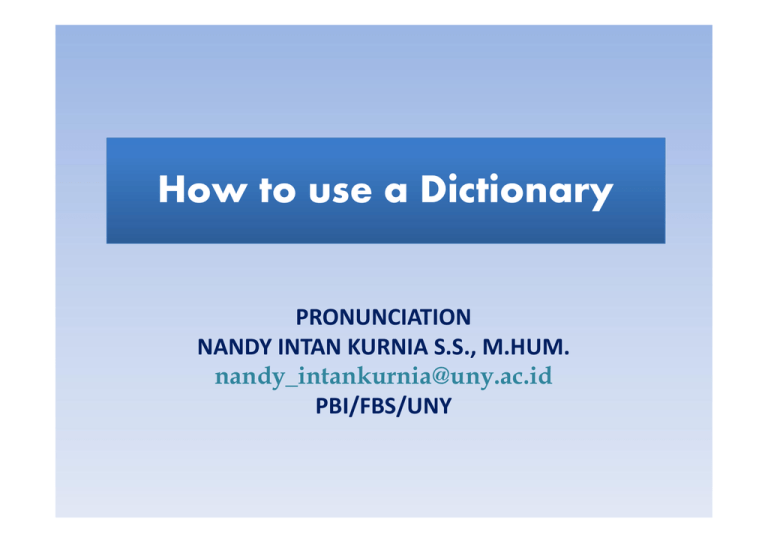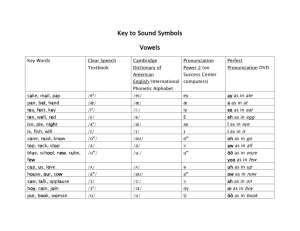How to use a Dictionary PRONUNCIATION NANDY INTAN KURNIA S.S., M.HUM. PBI/FBS/UNY
advertisement

How to use a Dictionary PRONUNCIATION NANDY INTAN KURNIA S.S., M.HUM. nandy_intankurnia@uny.ac.id PBI/FBS/UNY • Dictionary is for people who are learning English as a second or foreign language. • Dictionary can help you both as a reference book and as active learning tool. • A good dictionary can tell you a lot more about a word than just its meaning, including (among other things): • Word Entry: Words that are considered important and useful to study as the basis of the growing knowledge for learners learning English. The words in everyday life either in speaking or writing are selected and put into the dictionary in chronological order of English Alphabets. The words appearing in the dictionary in bold type and as the head word ( or the 1st word ) are called word entries. • Other spellings: If a word can be spelled into different ways, both British and American are shown. • Stress: Often shown by a mark / / (a little bar) before the syllable to be stressed or by underlining. • Pronunciation: Each word is followed by its pronunciation, given in the international Phonetic Alphabet. British and American pronunciation are shown to you . Look at the list of special pronunciation table; you will see common words next to the symbols .These words help you to learn to pronounce the sounds. *Key to phonetic symbols : Consonants & Vowels (British VS American English) • Parts of speech (or word class): Parts of the speech is the function of the word used in the sentence. It can help you locate the appropriate meaning of the word in a sentence. Usually parts of speech are shown in short forms following the pronunciation. For Example: v. = Verb n. = Noun adj. = Adjective adv. = Adverb prep. = preposition conj. = Conjunction c. = Countable n. uc. = Uncountable n. v.t. = Transitive v. • Definitions (meanings): The definitions or meanings comes right after the parts of speech. This part gives you the meaning of the word you are looking for. Usually words have more than one meaning. Choose the most appropriate meaning, which corresponds to the way, that the word is used in the sentence. A word with more than one meaning has numbered definitions, one for each meaning, often with example. • Example: Most definitions in dictionary are followed by examples that showed how the word is used. The examples may be in short phrases or whole sentences, and they are written in italic letters. • Synonyms: Sometimes it is useful to show a synonym, a word that has the same meaning, as the word that is being defined. This is shown after the definition. • Antonyms: A dictionary sometimes lists words with opposite meanings (antonyms). • Stylistics Value: The words that you are looking for in the dictionary have special use in language. The dictionary tells you the special use of the words you are looking for whether the are British (Br.) or American (Am.), colloquial (spoken language), archaic (old- fashioned words), literary (words used in literature), poetic or slang . This information is useful to foreign students of English who often have difficulty in understanding the special use of words. The Examples: • Color AmE // Colour BrE// ‘kΛl r/ n. 1. [U] The quality which allows one to see the difference between (for example) a red flower and a blue flower when both are the same size and shape: HUE. The color of my new car is bronze or bronze color. • Kid/ kId/ n. [C] 1(informal) a child or young person: How are you kids? Opp.Adult .2. Kid brother/sister(informal)(especially US) Younger brother/sister 3. A young goat Key to phonetic symbols : • Consonant P Pen/ pen/ B bad/bæd/ T tea/ti:/ D did/dId K cat/kæt/ G got/gŊt t∫ chin/t∫ dЗ June/dЗu:n/ f fall/f̣כּ:/ v voice/vכIs θ thin/θIn/ ð then/ðen s so/s∂υ/ z zoo/zu: In ∫ she/∫i:/ З vision/’vIЗn/ h how / haυ/ m man/mæn/ n no/n∂υ/ ŋ sing/sIŋ l leg/leg r red/red/ j yes/jes/ w wet/wet/ British English Vowels i: see/si:/ I sit/sIt/ e ten/ten/ æ hat/hæt/ a: arm/a:m/ כ: saw/sכ:/ υ put/pυt/ u: too/tu:/ Λ cup/kΛp/ З: fur/fЗ:(r)/ ∂ ago/∂’g∂υ/ eI page/peIdЗ/ ∂υ home/h∂υm/ aI five/faiv aυ now/naυ כI join/dЗכIn/ I∂ near/nI∂(r)/ e∂ hair/he∂(r)/ SOURCE This material is taken from various sources.







